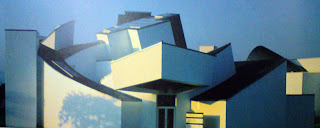Research
Vitra Design Museum was constructed in 1989 under the guidance of Alexander von Vegesack. The building was designed by Frank O Gehry and it consists of a steady swirl of white forms as the exterior with a powerful interlocking interior. Limiting the materials to only white plaster and titanium-zinc alloy evoked the "Balancing Tools" rules.
The sleek design creates a prestigious image of enterprise with its technical superiority. The museum is not dependent on the Vitra Company as it covers its own budgets through exhibitions and publications of themes of furniture design as the museum hold one of the largest collections of modern furniture designs.
Reference
http://www.design-museum.de/vitra/architektur/index.php?sid=0156492183380fbab3ebd24c3f5943f9&language=en
---
The design museum houses temporary exhibitions on themes of furniture design, and Gehry's building makes a suitable host for them - in keeping with the theme, but - once inside - supporting, not competing with, the exhibitions.
The geometry of the building does not feel contrived, or particularly noticeable, as you go around the exhibitions. From the outside it does feel both those things, but it is at home among the other architectural showpieces that make up the Vitra site.
Reference
http://www.galinsky.com/buildings/vitradesign/index.htm
---
"Frank Gehry has raised the bar for architectural innovation," said Thomas Krens, Director, Solomon R. Guggenheim Foundation. "He has accomplished this because of his openness to the concept of difference and radical juxtaposition. Place two unlikely elements together and Frank will say, 'Why not?' He is a master at transforming the material environment—whether natural or artificial—into architecture."
Reference
http://www.guggenheim.org/new-york/press-room/press-releases/
press-release-archive/2001/682-may-15-frank-gehry-architect
Sketchup 2D Graphics
Top view
 Side view
Side view Perspective
Perspective


---
Further Group Research
The Vitra Design Museum designed by Frank Owen Gehry began from the furniture producer, Rolf Felbaum’s wish to document the roots and history of his craft. And thus following his wish, he commissioned Frank Gehry to design The Vitra Design Museum, which in contrast to other museums, where furniture design is only one subject among many; it focuses principally upon its historical and future developments
Under the guidance of Alexander von Vegesack, the museum was completed and opened to the public in 1989.
The museum design houses qualities of a sculpted building with its steady swirl of white forms as the exterior combined with a powerful interlocking interior. Assembled by distinct volumes of random patterns - spirals, wedges, cubes, crosses and so on, it creates a harmonious structure as a whole, for they interlock by enclosing every shape of the museum together; staircases, vaulted galleries and ceilings. These dynamic shapes allow the museum to have boundless energy all around, from exterior to interior. In addition, the museum’s sleek design creates a prestigious image of enterprise with its technical superiority - a style which has been used by Frank Gehry throughout his designs. Above: The cubist assemblage of interlocking forms demonstrated in Frank Gehry's Vitra Design Museum.
Above: The cubist assemblage of interlocking forms demonstrated in Frank Gehry's Vitra Design Museum.Cruciform glazed openings from the structures of the building, such as the central roof on the second floor, provide the museum with extensive natural illumination. The use of white plaster also added to the building's vibrance as well as the titanium finishes. This limitation in the choice of materials evoked the "Balancing Tools" rules.

Above: The curve structure effectively wrapping and enclosing the staircase inside the building.
The museum is not dependent on the Vitra Company as it covers its own budgets through exhibitions and publications of themes of furniture design as the museum hold one of the largest collections of modern furniture designs. It's one of his successful overseas projects which helped him gain international recognition.
References
- Museum Architecture, Justin Henderson, Gloucester, Massachusetts, 1998.
- Frank Gehry Vitra Design Museum by Olivier Boissiere and Matrtin Filler
- http://www.design-museum.de/vitra/architektur/index.php?sid=0156492183380fbab3ebd24c3f5943f9&language=en





No comments:
Post a Comment